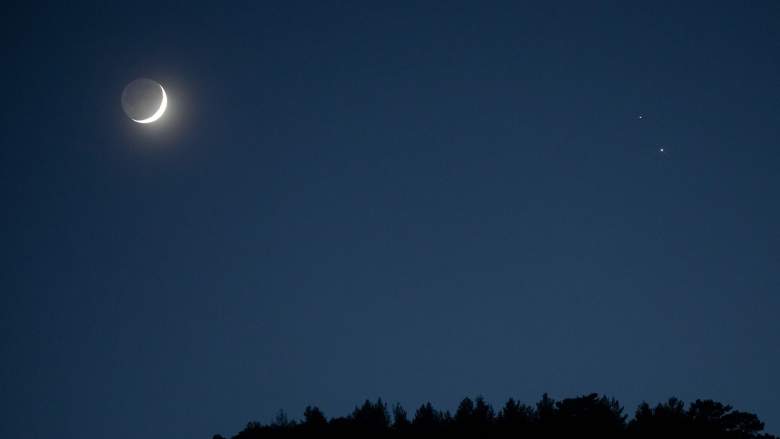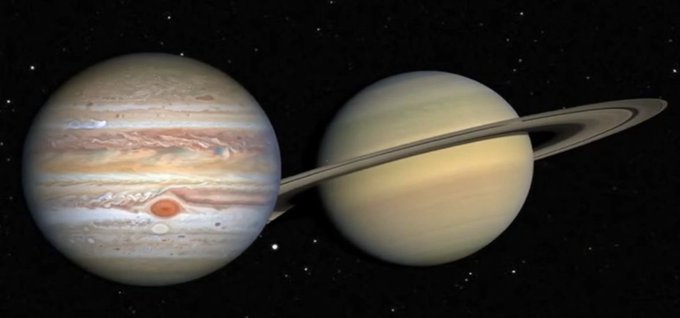
Getty A crescent moon (L) is seen with Saturn (upper right) and Jupiter (lower right) ahead of their closest visible conjunction on December 17, 2020 in Antalya, Turkey. On December 21, a Jupiter and Saturn conjunction will form a rare "double planet" for the first time in 400 years and will be the closest the two planets have been since 1623.
In an unprecedented year in the lives of most people living today— a year that has been marked by struggle and an uncertain future as people around the globe navigate life in the coronavirus pandemic, 2020’s December 21 winter solstice will coincide with another rare event. But thankfully, this rare worldwide event is a good one.
The “Great Conjunction,” also referred to as “The Christmas Star,” will be visible to almost everyone in the world according to NASA. The Great Conjunction means that Saturn and Jupiter will align so closely that NASA says the planets will look to be only one-tenth of a degree apart in the night sky to the naked eye, even though in actuality the planets will be hundreds of millions of miles apart.
According to NASA, this is a unique spectacle.
“It’s been nearly 400 years since the planets passed this close to each other in the sky, and nearly 800 years since the alignment of Saturn and Jupiter occurred at night, as it will for 2020, allowing nearly everyone around the world to witness this ‘great conjunction,’” according to the agency.
The first time this phenomenon was seen and recorded was in 1623, NASA reported, thanks to the discoveries of Galileo Galilei. That year “the solar system’s two giant planets, Jupiter and Saturn traveled together across the sky. Jupiter caught up to and passed Saturn, in an astronomical event known as a ‘Great Conjunction,’” NASA wrote.
The planets regularly appear to pass each other in the solar system, but not so close and not during a time when people can actually see it. The positions of Jupiter and Saturn align in the sky about once every 20 years. The next time NASA says the two planets will appear to be so close is 2080.
According to Henry Throop, an astronomer in the Planetary Science Division at NASA Headquarters in Washington “You can imagine the solar system to be a racetrack, with each of the planets as a runner in their own lane and the Earth toward the center of the stadium. From our vantage point, we’ll be able to be to see Jupiter on the inside lane, approaching Saturn all month and finally overtaking it on December 21.”
To See the Great Conjunction on December 21, Just Look Toward the Southwest Shortly After Sunset
If skies are clear where you live, and you can get to a place with an unobstructed view of the sky, chances are you can see the planets appear to meet in the night sky.
Here are NASA’s instructions on how to see the so-called “Christmas Star”:
For those who would like to see this phenomenon for themselves, here’s what to do:
Find a spot with an unobstructed view of the sky, such as a field or park. Jupiter and Saturn are bright, so they can be seen even from most cities.
An hour after sunset, look to the southwestern sky. Jupiter will look like a bright star and be easily visible. Saturn will be slightly fainter and will appear slightly above and to the left of Jupiter until December 21, when Jupiter will overtake it and they will reverse positions in the sky.
The planets can be seen with the unaided eye, but if you have binoculars or a small telescope, you may be able to see Jupiter’s four large moons orbiting the giant planet.
Planetary Conjunctions Happen Regularly & Astrologers Ascribe Meaning But Science Says There Is No Evidence to Support That
If science’s job is to understand the physical laws of the universe, astrology’s goal to understand whether the position of celestial bodies has influence over humanity and if so, what can be predicted?
With such a rare, close planetary conjunction falling on the winter solstice, and humanity’s intrinsic need to assign meaning to life on earth, astrologers have long had their own theories, even while scientists chalk up the planetary alignment as simply the way things worked out.
According to Throop:
Conjunctions like this could happen on any day of the year, depending on where the planets are in their orbits. The date of the conjunction is determined by the positions of Jupiter, Saturn, and the Earth in their paths around the Sun, while the date of the solstice is determined by the tilt of Earth’s axis. The solstice is the longest night of the year, so this rare coincidence will give people a great chance to go outside and see the solar system.
University of Rochester historian Laura Ackerman Smoller wrote of the ancient beliefs affiliated specifically with the conjunction of Saturn and Jupiter. She said of the medieval beliefs about the planetary alignment:
Saturn and Jupiter were the two outermost planets in the Ptolemaic system; other planets had not yet been discovered. They are also the two slowest moving ones. According to doctrines that medieval European astrologers learned from Arabic astrologers, whose works—translated into Latin in the twelfth century—formed the basis of medieval and Renaissance astrology, it’s when Saturn and Jupiter are found in the same area of the zodiac—in other words when they are in conjunction—that there are profound effects on Earth.
Astrologer Emily Segal still ascribes to that theory, writing in The Guardian that the conjunction “marks the birth of a new astrological epoch.” She wrote:
Besides its visual dazzle, this event has special significance through an astrological lens: it marks the official shift from a 200 year period during which Jupiter and Saturn made conjunctions primarily in Earth signs into a 200 year period of conjunctions in Air signs, marking the advent of a new epoch in a larger 800 year macro-cycle.
Historically, Earth periods like the one we are about to exit focus on materialism, hierarchies, resource acquisition, territory control, and empire stabilization (see the late Roman empire, high middle ages, and industrial capitalism). Air periods, by contrast, favor the renovation of hierarchies, decentralization, shifting orders, rapid translation, mass mobility, trade networks, and rampant spirituality.
Science rejects the ancient belief system of astrology, but if nothing else, mother nature is bestowing a rare gift of beauty to everyone in the world tonight as Saturn and Jupiter appear to get close enough to kiss. At the end of 2020, the Great Conjunction is a welcome reminder of the continuity of the universe and things bigger than ourselves.
READ NEXT: Man, 29, Killed Stepdad When Asked to Stop Playing Video Games: Police

